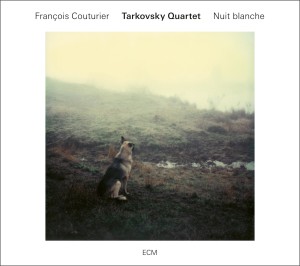 The French pianist François Couturier continues a project of more than a decade now of honoring the spirit of Russian filmmaker Andrei Tarkovksy (1932-1986). Nuit Blanche or White Night, by what is known as the Tarkovsky Quartet, is the fourth release in a series going back to 2005. This is my first exposure to the ensemble, its music and even the awareness of Tarkovsky himself, but this release definitely stands on its own as a stunningly beautiful work.
The French pianist François Couturier continues a project of more than a decade now of honoring the spirit of Russian filmmaker Andrei Tarkovksy (1932-1986). Nuit Blanche or White Night, by what is known as the Tarkovsky Quartet, is the fourth release in a series going back to 2005. This is my first exposure to the ensemble, its music and even the awareness of Tarkovsky himself, but this release definitely stands on its own as a stunningly beautiful work.
The quartet in addition to Couturier on piano is made up of Anja Lechner on cello, Jean-Marc Larché on soprano saxophone, and Jean-Louis Matinier on accordion. The music, as you might imagine from that lineup, is a heady blend of classical, jazz, cabaret and more, and it’s all very cinematic.
This is highly evocative music, the kind you’d expect to find on the soundtrack of a film, and it’s intentionally so. In fact this album is laden with more references to films, soundtracks and insider knowledge of them than anyone but the most obsessive Tarkovsky fan could find. But again, you don’t need any of that to enjoy it.
The recording seems to do a complicated dance around two centers of gravity. One is the 11-minute, episodic and epic “Urga,” the other a reimagining of a Vivaldi work “Cum Dederit Delectis Suis Somnum.” Around them, numerous shorter works circle, most of them named “Dream” in English, French (rêve) or German (traum), with others of similar title including “Fantasia,” “Daydream” and “Nightdream.” They’re all seemingly improvs on similar themes, some light and almost airy like “Dream III” with mysterious percussive sounds behind snatches of stately melody from the piano, resembling a fairy-tale ballroom dance heard through a distant window. Others are more mysterious, portentous and even vaguely disturbing like “Rêve II” with its high-pitched, cat-on-the-keyboard motif or “Dream IV” with its dark drones, squeals and thuds.
“Urga” is quite simply one of the most impressive lengthy pieces I’ve encountered in some time, impossible to tell how much is scored and how much improvised. It runs through mood after mood, the ensemble members handing off the lead, Couturier regularly moving in on piano to shift from one section to the next. Languid moods meld into urgent themes, colors and textures shift kaliedoscopically, and themes rise, dominate and fade.
And the two “classical” pieces seem to anchor the proceedings in slightly more solid, composed moods. The arrangement of the anonymous German piece from around 1500, “Quant ien congneu a ma pensee,” (roughly translated as “when I consider it in my mind”) is particularly stately and poignant, Lechner’s cello a pure delight.
The recording’s raison d’etre comes through in an epigraph by Ingmar Bergman in the liner notes: When film is not a document, it is a dream. That is why Tarkovsky is the greatest of them all. He moves with such naturalness in the room of dreams. Couturier and this ensemble take the listener into that room of dreams.
(ECM, 2017)
